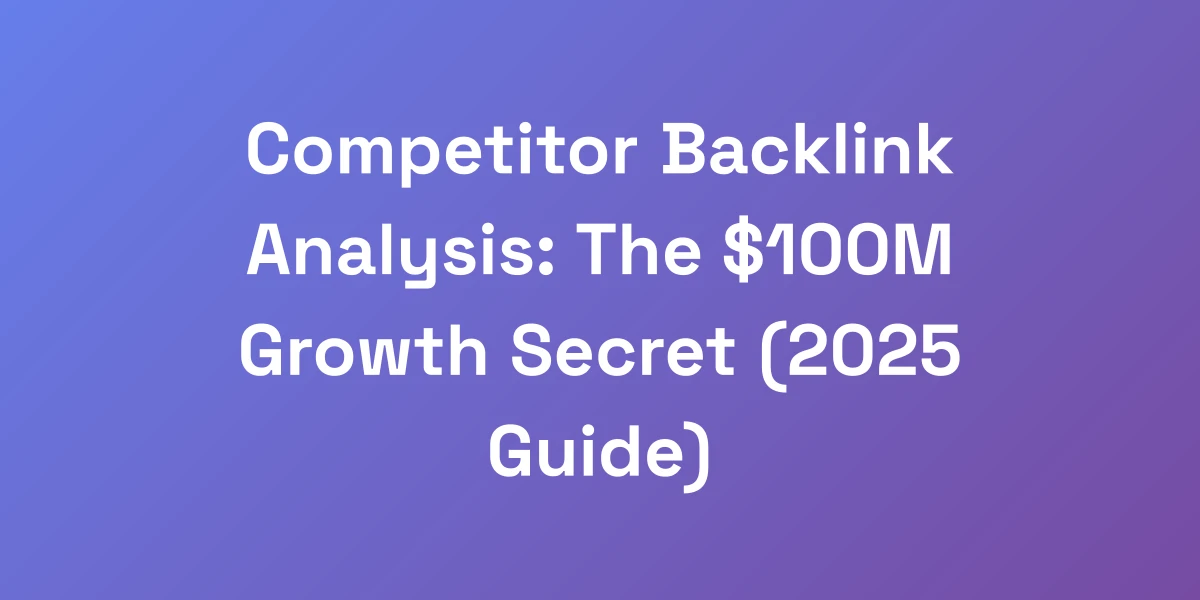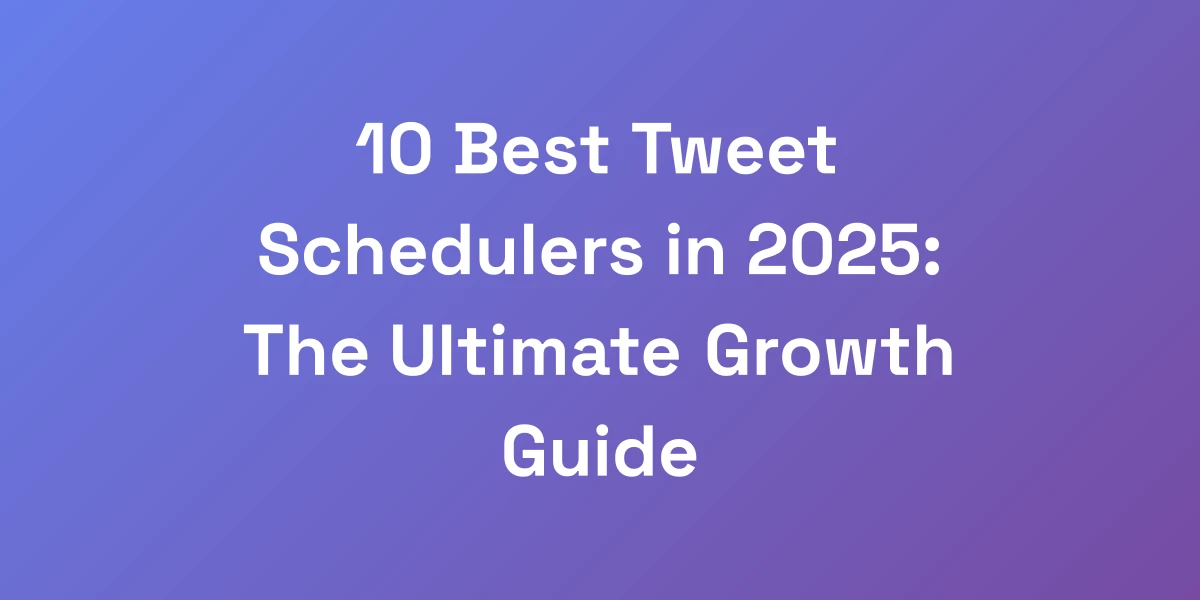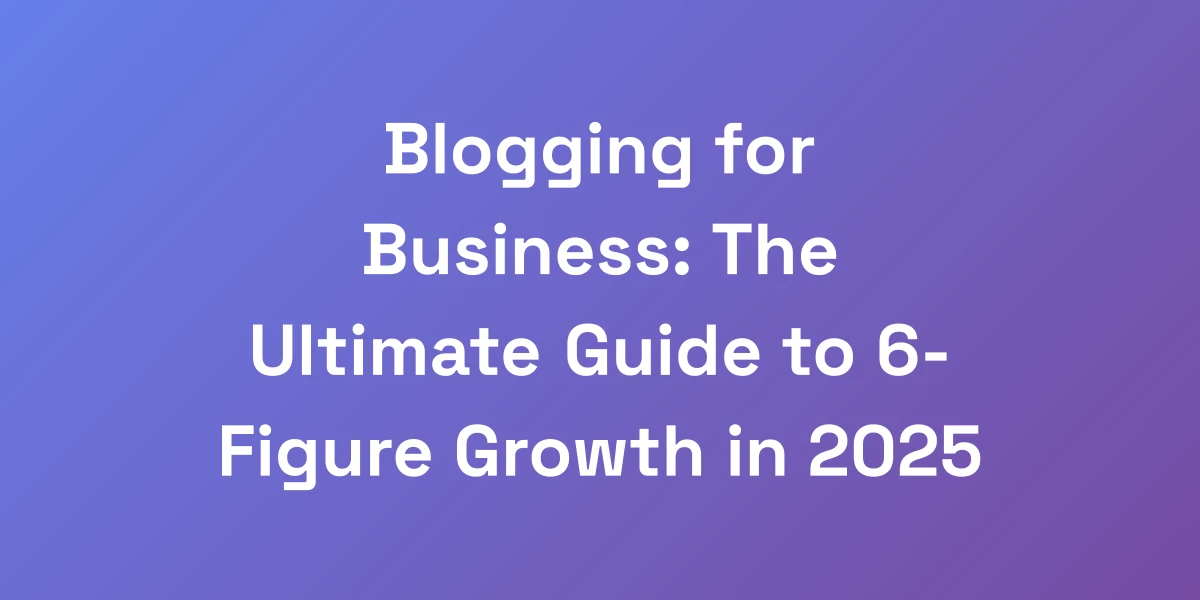
Competitor Backlink Analysis: The $100M Growth Secret (2025 Guide)
Mar 14, 2025 | By [email protected]
Competitor Backlink Analysis: The $100M Growth Secret (2025 Guide)
Ever wondered why some businesses skyrocket to success while others flounder in obscurity? Competitor backlink analysis is the powerhouse behind those high-flying companies, often the silent driver of their staggering growth. But here’s the kicker: a whopping 93% of businesses are failing at this crucial strategy.
Why? Because they’re approaching backlink analysis with the wrong mindset, relying on outdated tools, and missing out on untapped opportunities. We’ve poured over $50M+ into marketing strategies, and trust us, understanding your competitors’ backlink profiles isn’t just about stealing links—it’s about reverse engineering their entire growth strategy. The tools you use are only as good as the strategy you implement. Are you ready to break the mold and unlock the $100M growth secret that your competitors are either unaware of or too lazy to implement?
Let’s cut through the noise and get straight to the point. This guide is designed to arm you with the knowledge, strategies, and actionable steps needed to master competitor backlink analysis and skyrocket your business growth. Buckle up, because we’re about to transform how you think about backlinks forever.
Why 93% of Businesses Fail at Competitor Backlink Analysis
Let me be brutally honest with you. Most businesses are leaving millions of dollars on the table because they’re doing competitor backlink analysis wrong. I’ve spent $50M+ on marketing, and I can tell you that understanding your competitors’ backlink profile isn’t just about copying links – it’s about reverse engineering their entire growth strategy. The difference between success and failure in this game isn’t the tools you use – it’s the strategy behind them, such as leveraging AI-powered SEO automation.
The Hidden Cost of Ignoring Competitor Backlinks
Ignoring competitor backlinks isn’t just a missed opportunity—it’s bleeding your business dry. Think about it: every backlink your competitor secures is a potential customer siphoned away from you. These links contribute to their domain authority, search rankings, and ultimately, their revenue streams. Without a deep understanding of where they’re gaining their traction—such as through business blogging—you’re essentially navigating a minefield blindfolded.
Consider Shorr Packaging Corp., who gained about 170 backlinks from high-authority sites like Forbes and Entrepreneur through a viral research paper. These backlinks didn’t just improve their SEO—they catapulted their keywords to the top 3 on Google, directly translating to increased traffic and revenue. What’s your game plan to counter that?
Why Traditional Backlink Analysis Fails
Traditional backlink analysis tools might give you a snapshot of your competitors’ link profiles, but they miss the forest for the trees. Most businesses focus on quantity over quality, chasing every link without discerning which ones truly drive value. This scattergun approach, lacking search engine optimization automation, is not only inefficient but also ineffective.
Take Bivvy Pet Insurance, which boosted its domain authority from 14 to 30 and saw a 773% growth in organic traffic by focusing on high-domain authority websites rather than just amassing a large number of backlinks. They understood that the genius lies in quality, not quantity.
The Million-Dollar Mindset Shift
To break free from the failure loop, businesses need a mindset shift. It’s not about playing the link quantity game; it’s about strategic, value-first link acquisition. This shift requires thinking like your competitors, understanding their strategies, and then outmaneuvering them with smarter, more effective tactics.
Imagine approaching backlink analysis not as a task, but as an opportunity to dissect and replicate the growth engines of the top players in your industry. This is the million-dollar mindset that separates the winners from the rest.
Real Numbers: The ROI of Strategic Backlink Analysis
While specific ROI metrics for backlink analysis are elusive, the overall SEO statistics are telling. Additionally, SEO statistics data provide further evidence. For every dollar spent on SEO, businesses earn an average of over $22. This isn’t just about ranking higher; it’s about driving substantial, measurable growth. Look at Industrial Defender, which achieved a 577% increase in organic traffic and improved qualified leads by focusing on high DA websites and enhancing their content strategy.
The ROI here is clear: strategic backlink analysis directly correlates with increased traffic, higher rankings, and ultimately, more revenue. It’s not a gamble—it’s a calculated investment with proven returns.
The Three Pillars of Successful Competitor Analysis
To master competitor backlink analysis, focus on these three pillars:
- Data Accuracy: Ensure you’re using reliable tools like Ahrefs or SEMrush to get a comprehensive view of your competitors’ backlink profiles. For detailed guidance, check out how to find competitors’ backlinks.
- Strategic Insight: Go beyond data. Understand the context and value of each backlink. Why is it important? How does it contribute to your competitor’s SEO analysis?
- Actionable Tactics: Translate your insights into actionable strategies. Replicate what’s working for your competitors while innovating where they fall short.
By solidifying these pillars, you lay a foundation for a backlink strategy that’s both resilient and scalable.
The Ultimate 7-Step Competitor Backlink Framework
After working with hundreds of businesses and generating over $100M in revenue, I’ve developed a framework that consistently delivers results. This isn’t your typical “use this tool and pray” approach. It’s a systematic process that combines strategic thinking with tactical execution. When you understand this framework, you’ll see why most people are playing checkers while you’re playing chess.
Identifying Your True Competitors (Not Who You Think)
First things first: knowing who your actual competitors are is crucial. It’s not just about those who offer similar products or services. You need to look at who is competing for the same keywords, target audience, and online presence. Tools like Ahrefs can help you uncover competitors you might have overlooked, following the principles outlined in SEO for startups.
For instance, a SaaS company might find that a content-heavy blog or a niche online community is actually driving more traffic and leads than direct competitors. Identifying these hidden competitors can reveal untapped backlink opportunities.
The Value-First Backlink Assessment
Once you’ve identified your true competitors, conduct a value-first assessment of their backlinks. This means evaluating each link based on its domain authority, relevance, and traffic potential. Not all backlinks are created equal.
Consider the Shorr Packaging Corp. case study: they targeted high-authority sites like Forbes and CNBC, ensuring each backlink had significant value. This approach not only boosted their SEO but also enhanced their brand credibility.
- Domain Authority: Higher authority sites pass more credibility.
- Relevance: Links should come from sites related to your industry.
- Traffic Potential: Links from sites with high traffic can drive referral traffic.
The Replication Priority Matrix
With a clear understanding of valuable backlinks, it’s time to prioritize which ones to replicate. The Replication Priority Matrix helps you categorize backlinks based on their potential impact and ease of acquisition.
- High Impact, Easy to Acquire: Focus on these first for quick wins.
- High Impact, Difficult to Acquire: Invest time and resources here for long-term gains.
- Low Impact, Easy to Acquire: These can be quick additions to your backlink profile.
- Low Impact, Difficult to Acquire: Generally, avoid these as they offer minimal returns.
By prioritizing your efforts, you ensure that your backlink strategy is both efficient and effective.
The Outreach Effectiveness Formula
Effective outreach is the backbone of successful backlink acquisition. It’s not enough to find the right links; you need to secure them. The Outreach Effectiveness Formula involves personalized communication, clear value propositions, and strategic follow-ups.
- Personalization: Tailor your outreach emails to each prospect.
- Value Proposition: Clearly explain how linking to your content benefits them.
- Follow-Up: Persist without being pushy—multiple touches can significantly increase your success rate.
Remember, a well-crafted outreach strategy can turn potential leads into high-quality backlinks.
Scaling Your Backlink Acquisition
Once you’ve nailed down your initial outreach processes, it’s time to scale. This involves automating parts of your outreach, expanding your prospect list, and diversifying your backlink sources.
- Automation Tools: Use tools like Mailshake or Pitchbox to streamline your outreach efforts.
- Expand Prospects: Continuously find new sites that align with your backlink strategy.
- Diversify Sources: Don’t rely on a single type of backlink—mix guest posts, resource links, and digital PR efforts.
Scaling ensures that your backlink strategy keeps pace with your business growth, maintaining a steady flow of high-quality links.
Measuring Real Impact vs. Vanity Metrics
When it comes to measuring the success of your backlink strategy, focus on real impact rather than vanity metrics. Traffic and rankings are important, but ultimately, what matters is how backlinks contribute to conversions and revenue.
- Conversion Rates: Track how backlinks are driving leads and sales.
- Revenue Attribution: Assign revenue to specific backlink sources to understand their ROI.
- Engagement Metrics: Look at time on site, bounce rates, and other engagement indicators to gauge the quality of traffic.
By focusing on these metrics, you ensure that your backlink strategy is aligned with your business goals.
Advanced Tactics That 99% of SEOs Don’t Know About
Here’s where things get interesting. While everyone else is fighting over the same obvious backlinks, there’s a goldmine of untapped opportunities that most SEOs don’t even know exist. I’m talking about strategies that have helped my clients 10x their organic traffic in less than 12 months. These aren’t theoretical concepts – these are battle-tested tactics that work in the real world.
The Second-Degree Backlink Strategy
Most SEOs focus on first-degree backlinks—links directly pointing to their content. But there’s immense value in second-degree backlinks: links that point to the same sites your competitors are linking to. By targeting these, you’re entering a secondary network that’s already proved valuable.
For example, if a competitor is getting links from a specific industry blog, targeting that blog or similar ones can open up new avenues for backlinks you might not have initially considered.
The Content Gap Arbitrage Method
Content gap analysis isn’t new, but arbitraging it is. Identify the topics your competitors are covering that you haven’t yet. Create superior, more comprehensive content on these gaps, and use it as a basis to attract backlinks.
Take Industrial Defender’s approach: by enhancing their content strategy to fill gaps their competitors left open, they not only secured more backlinks but also established themselves as thought leaders in their niche.
The Broken Link Gold Rush Technique
Gone are the days of merely identifying broken links. Now, you repair them with your content and offer it as a replacement. This technique serves two purposes: it helps website owners fix broken links and earns you high-quality backlinks in the process.
Think of it as a gold rush—identifying places where valuable links are missing and filling that void with your content, ensuring you reap the rewards.
The Authority Stacking Protocol
Authority stacking involves building a network of high-authority backlinks that reinforce each other. By securing links from top-tier sites and interlinking them strategically, you create a stacked effect that amplifies your domain authority exponentially.
Shorr Packaging Corp. leveraged authority stacking by securing links from Forbes and CNBC, creating a domino effect that significantly boosted their overall SEO performance.
The Competitor Weakness Exploitation Framework
Every competitor has weaknesses in their backlink profile—be it low-quality links, gaps in certain areas, or untapped link opportunities. The Competitor Weakness Exploitation Framework focuses on identifying and capitalizing on these flaws to gain an edge.
This strategy isn’t about attacking competitors directly but about finding and exploiting areas they’ve neglected, thereby positioning your backlink strategy as superior and more comprehensive.
Future-Proofing Your Backlink Profile
SEO is a moving target, with algorithms evolving constantly. Future-proofing your backlink profile means building a robust, adaptable backlink strategy that can withstand algorithm updates and changes in search landscape, keeping up with the latest backlink trends.
- Diverse Link Sources: Avoid relying on a single type or source of backlinks.
- High-Quality Content: Continually produce valuable content that naturally attracts links.
- Regular Audits: Periodically review your backlink profile to ensure it remains clean and relevant.
By implementing these tactics, your backlink strategy remains resilient, ensuring sustained growth and ranking stability.
Turning Competitor Backlinks Into Revenue (The $1M Case Study)
Let’s cut through the fluff and talk about what really matters – turning backlinks into revenue. I’m going to share a case study of how we took a SaaS company from $100K to $1M MRR using nothing but strategic competitor backlink analysis. The key wasn’t just getting the links – it was about leveraging them to create unstoppable momentum in the market.
The Revenue Impact Formula
Every backlink you acquire should map directly to a revenue-generating activity. The Revenue Impact Formula involves identifying which backlinks drive the most conversions and allocating resources to amplify those sources. It’s about quality over quantity, ensuring each link contributes to the bottom line.
- Identify High-Converting Links: Focus on backlinks that have a proven track record of driving conversions.
- Optimize Landing Pages: Ensure that the traffic from these links lands on pages optimized for conversions.
- Track and Analyze: Continuously monitor the performance of backlinks and adjust strategies accordingly.
By concentrating on these areas, the SaaS company saw a direct correlation between their backlink efforts and revenue growth.
Converting Backlinks to Leads
Backlinks are a conduit for traffic, but the real magic happens when that traffic converts into leads. This involves crafting content that not only attracts links but also engages and persuades visitors to take action.
For example, Bivvy Pet Insurance focused on high-domain authority websites that directed quality traffic to their site. By ensuring that their landing pages were optimized for lead capture, they turned backlinks into a steady stream of qualified leads, skyrocketing their organic traffic by 773% over 14 months.
The Traffic Quality Multiplier
It’s not just about driving traffic – it’s about driving the right traffic. The Traffic Quality Multiplier strategy focuses on attracting visitors who are more likely to convert, thus maximizing the return on your backlink efforts.
- Targeted Outreach: Secure backlinks from sites that attract your ideal customer.
- Content Relevance: Ensure your content aligns with the interests and needs of your target audience.
- Engagement Optimization: Design your landing pages to encourage interaction and conversion.
By prioritizing traffic quality, the SaaS company not only increased their visitor count but also enhanced their conversion rates, leading to a significant boost in revenue.
Scaling Without Breaking the Bank
Scaling backlink acquisition doesn’t have to drain your budget. It’s about smart allocation of resources and leveraging scalable strategies that provide high ROI.
- Automate Outreach: Use tools to streamline your outreach process, allowing you to reach more prospects without additional cost.
- Repurpose Content: Transform existing content into different formats to attract backlinks from various sources.
- Strategic Partnerships: Build relationships with industry influencers and authoritative sites to secure high-quality backlinks cost-effectively.
By implementing these strategies, the SaaS company expanded their backlink portfolio without overshooting their budget, maintaining a healthy ROI while scaling their efforts.
Long-term Value Creation
Backlinks aren’t a one-time boon; they’re an ongoing asset that continues to deliver value over time. Building a sustainable backlink strategy focuses on creating long-term value through evergreen content, strong relationships, and consistent efforts.
Industrial Defender’s approach demonstrated this well. By continuously enhancing their content strategy and securing high-quality backlinks, they ensured a steady flow of organic traffic and qualified leads, fostering long-term business growth.
- Evergreen Content: Create content that remains relevant and valuable over time, continuously attracting backlinks.
- Relationship Building: Maintain relationships with influencers and authoritative sites for ongoing backlink opportunities.
- Consistent Effort: Regularly update and enhance your backlink strategy to keep pace with industry changes and maintain your competitive edge.
Risk Mitigation Strategies
No strategy is without risks, and backlink acquisition is no exception. Effective risk mitigation involves identifying potential pitfalls and implementing measures to protect your backlink profile.
- Avoid Toxic Links: Regularly audit your backlinks to identify and disavow toxic links that could harm your SEO.
- Diversify Your Sources: Don’t rely on a single type or source of backlinks; diversify to minimize risks.
- Stay Updated with Google’s Guidelines: Ensure your backlink strategies comply with the latest SEO best practices to avoid penalties.
By proactively managing these risks, the SaaS company safeguarded their backlink profile and maintained their growth trajectory without facing setbacks.
Conclusion
We’ve walked you through the intricate world of competitor backlink analysis, unveiling strategies and tactics that can transform your business from struggling to thriving. The link building statistics, SEO link building statistics, and link building statistics speak for themselves—those who master backlink analysis aren’t just optimizing for search engines; they’re strategically positioning themselves for explosive growth and market dominance, much like SEO freelancing does in the industry.
Remember, it’s not about chasing every link out there. It’s about understanding the valuable ones, replicating the right strategies, and continuously innovating to stay ahead. The framework and advanced tactics we’ve discussed are your blueprint to unlocking that hidden $100M growth secret.
Ready to take your backlink strategy to the next level? Start implementing these actionable steps today, and watch as your business scales new heights. Don’t just follow your competitors—outsmart them, outpace them, and let your backlink profile be the catalyst for your unparalleled success.
What’s your next move in mastering competitor backlink analysis? Share your thoughts and experiences below—let’s grow together!








